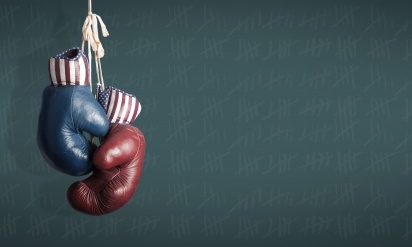Marketing in an “Us vs. Them” World, Part 1: On Consumer Polarization
- The severity of social polarization in Europe (and beyond) has been rising and, in many countries, is currently at its highest since WWII.
- Seeing the world through an "us vs. them" lens has been coded in our brains by evolution.
- Social polarization has been on the rise because of social media, a culture of safetism, and more countries being led by polarizing leaders. It's become a vicious cycle.
- These societal changes do impact your brand and its everyday marketing activities, even if it may not seem so.

It’s an “us vs. them” world, like never before

On average, during the last decade, the level of polarization has increased by more than five points. If we are to compare it with other less polarized periods (e.g., the 1960s), we can say that in the last seven years, polarization has almost tripled to the point that in most countries, the election with the highest level of polarization since the Second World War has taken place in the last ten years.
The same trend is occurring in the USA, with Americans becoming polarized faster than any other nation.
Why is the world becoming so polarized?
Seeing others through the lens of “us vs. them” is how the human brain-mind naturally perceives the world. Throughout the 1970s, two psychologists, Henri Tajfel and John Turner researched social identity and prejudice, which helps to explain this tendency. Their study showed that polarization happens naturally (i.e., it’s coded in our brains) in three steps:Step 1: Social categorization
Much of our identity is shaped by the social groups we belong to — the country we come from, the political party we vote for, the football team we support, or even what we eat, and how often we think people should get “the jab.” These groups are a source of identity and self-esteem. We’re proud to be their members. They make us feel like we belong. They provide us with a feeling of safety (Imagine not belonging to any group and not knowing who are “your people.”). We see the world as a collection of these social groups and people as their members.Step 2: Social identification
Because we see the world as a collection of social groups, we automatically identify with some of them and not identify with others. There is “us,” and there is “them.” Tajfel’s research showed just how strong this tendency is. We don’t have to share experiences, history, or values with others to start feeling like we’re members of the same (or opposing) group. Even people divided into groups based on random incidents, such as a coin toss, immediately started displaying behaviors that favored their in-group members and discriminating against out-group members.
Step 3: Social comparison
We compare these social groups and use different judgment criteria to make evaluations, depending on whether we’re evaluating members of our group or “others.”If someone is from our group (an in-group member), we focus on characteristics that unite us. If someone is from a group we don’t belong to (an out-group member), we focus on features that differentiate us. The consequence is that we even more strongly perceive “us” to be like us and “them” to be different from us.
If an in-group member does something wrong, we tend to explain their behavior with external factors, i.e., situation (He didn’t help her because he was in a hurry.). When an out-group member does the same thing, we tend to assign their behavior to internal factors (He is a heartless person.). Consequently, we’re more likely to perceive all out-group members as fundamentally flawed people, for example, by applying negative stereotypes.
Finally, Tajfel’s research showed that when we feel part of a group, we want to maximize the relative position of that group to an out-group, even if it means receiving objectively less. We intentionally choose what’s worse for “them,” even if it’s worse for “us,” too.
Four reasons social polarization has recently been on the rise
This tendency to see the world as an “us vs. them” world is nothing new. It has been coded in our brains thousands of years ago by evolution and has helped our ancestors to thrive in a dangerous and uncertain world (you can read more about the how and why here). If the mechanism is so ancient, why the recent rapid rise in prejudice and hate?
#1: Social media
We’ve all heard of social media bubbles and algorithms that “lock us in” and prevent us from seeing a more objective version of reality, or at least a more diverse spectrum of opinions. The human mind has a natural tendency to notice and pay attention to information that supports our views and to neglect or oversee information that contradicts our beliefs. It’s one of the reasons we’re so prone to look at other people through the “us vs. them” lens.Several cognitive biases explain this phenomenon, most importantly confirmation bias: our tendency to search for, interpret, favor, and recall information in a way that confirms or supports our prior beliefs or values. (If you speak Polish, you can read more about it here. If you don’t, this article may be of interest).
The social media reality feeds on this limitation of the human mind. The result is a vicious cycle: We have an illusion that everyone has the same opinion as us, and in the rare instances when we are exposed to a different perspective, our mind neglects to acknowledge the information. It’s a perfect feeding ground for social polarization.
#2: Culture of safetism
Greg Lukianoff and Jonathan Haidt conducted an interesting analysis that makes a conveying point: The way many young people have been raised has led to the creation of a culture of safetism. They conclude that, in the name of emotional well-being, Generation Z (and beyond?) are increasingly demanding protection from ideas, values, and opinions they don’t like. They provide an overwhelming number of examples, such as:- Law students asking professors at Harvard not to teach rape law (it causes students distress)
- Comedians such as Chris Rock and Jerry Seinfeld no longer wanting to perform at US colleges because of the type of response they’ve been getting (”student can’t take a joke”)
- Students from liberal campuses organizing violent protests because speakers with conservative views have been invited to speak at their campuses
- Professors being forced to quit as a consequence of students rebelling against opportunities to be exposed to different values and opinions.

#3: Polarizing leaders
Sometimes “us vs. them” worlds are created intentionally by political leaders. Not to look too far, according to Thomas Carothers and Andrew O’Donohue from Carnegie Endowment for International Peace, it seems to be happening now in Poland:
Figures like […] Jarosław Kaczyński in Poland [...] have relentlessly inflamed basic divisions and entrenched them throughout society (often with resounding electoral success). They’ve aggravated tensions not only by demonizing opponents and curtailing democratic processes but also by pushing for radical changes—like a total ban on abortion in Poland.
The consequences of polarization don’t motivate political leaders to respond—politicians who play a role in fueling polarization benefit from it and bear little of the cost.
#4: A vicious cycle of escalation
Finally, polarization breeds polarization. It’s a vicious cycle:- We see other people as “them.”
- We discriminate against “them” and more intensely focus on things that divide us rather than unite us.
- We are likelier to say and do things that harm “them.” When that happens, “they” respond and say or do something to harm us. Then we respond, and they respond again... and so on. Each response is slightly more intense, leading to an escalation of conflict. Indeed, analyses show that polarization tends to escalate at a dizzyingly fast pace, often in just a few years.





